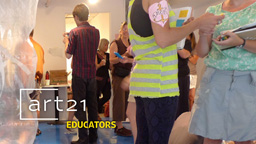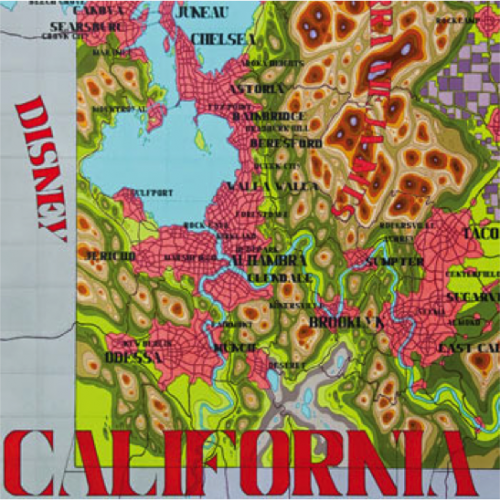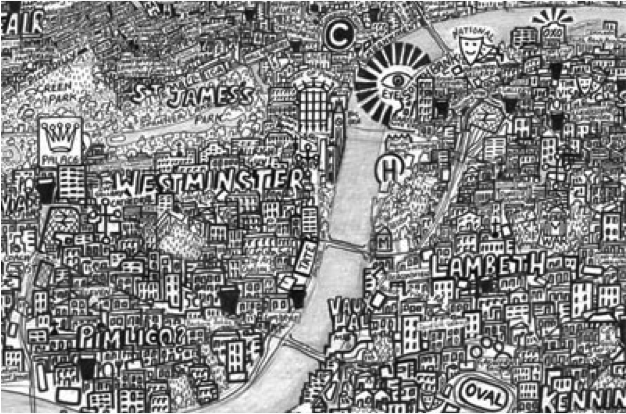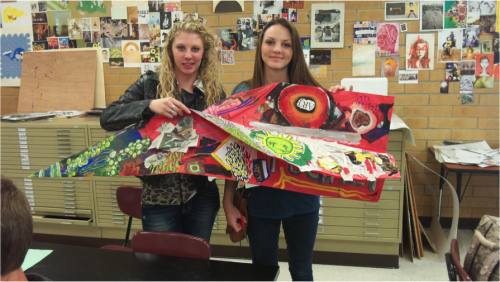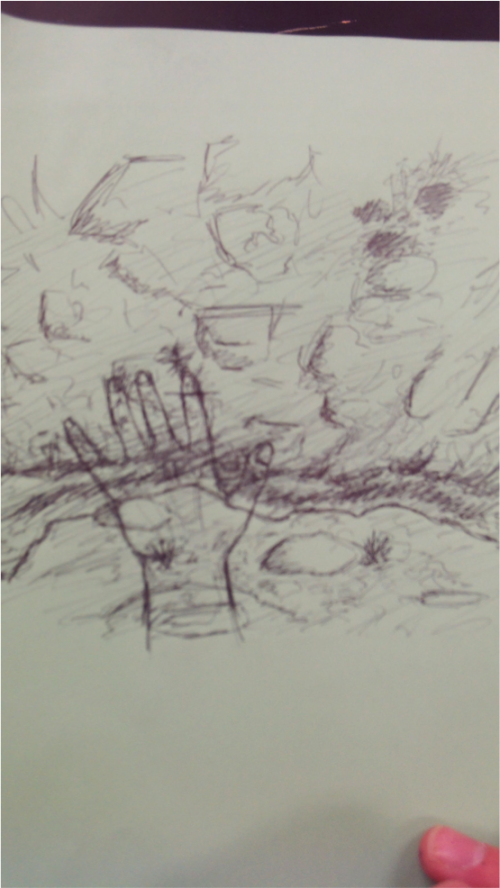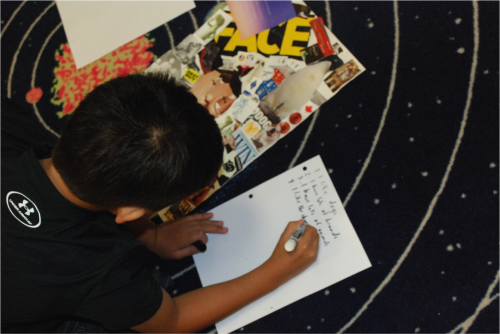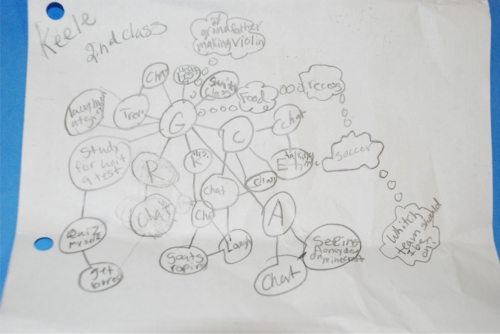This is a three-part series that will share the experiences of three Art21 Education staff members (Jessica Hamlin, Joe Fusaro, and Flossie Chua) after spending a year with a group of 16 incredible teachers. Each of us has a unique perspective on the past twelve months and this series will ruminate on what it means to teach with contemporary art, specifically contextualized by our experiences this year working with the Art21 Educators program.
It was the year of living dangerously.
When I think about my first year with Art21 Educators as its interdisciplinary consultant, that is the description that comes to mind. Dangerous. Not in the sense of a threat, but in that there was an enormous amount of risk-taking that was taking place. I was taking risks that I had not thought I would have to. And I was working with three incredible educators who were taking risks in their professional lives, and challenging themselves to step outside their comfort zone.
Let me begin with Chris Tourre, who teaches Technology (Art and Media) to 9th and 10th graders in a charter school. Chris teaches art in a school that doesn’t have an art program. To get art supplies for his classroom, he had to apply for a grant, and even then the materials were used up quickly. In the year that I worked with him, Chris had only pencil and paper for his art classes. There were of course computers that his students could work on, but that just about summed up the resources he had.
That wasn’t the only hurdle Chris had to cross in his teaching. High incidences of truancy and suspension among his students also meant that they were likely to miss lessons. When they could not follow the learning, the students were likely to mentally check out of the class altogether. Exacerbating that were the low levels of agency among his students. Study art? That wasn’t something that was high on their priority list.
Anyone would have been overwhelmed. Instead, Chris reframed the challenges he faced as opportunities. In his work with us, he decided to explore what it meant for an art class to work with scarce resources. What would excite and engage his students so that they felt empowered in their learning? How would they create art using minimal resources? How should he design a curriculum unit that goes beyond the making of art, a unit that empowers his students to create something meaningful and relevant to them?
What came out of Chris’ reflection was a compelling unit on the impact of geography on power and social issues in American culture. In his classroom, Chris invited his students into a challenging problem space: what are power relationships between people? How does where you live change your story? How can art create agency within race/cultural relations? It was a dangerous gamble: not only was he designing a unit that would challenge students’ assumptions about art classes (“aren’t we making pretty things?”), he was also inviting their personal stories into the public space of the classroom. How comfortable would they be opening up to their peers and the teacher? How would they respond to suddenly being at the center of meaning making?
The gamble paid off. By framing the guiding questions to directly “speak” to the students, Chris not only piqued their curiosity, he also acknowledged their personhood. His students realized that he was interested in their story, and that an adult thought they had something to say that was worth listening to during valuable classroom time. Suddenly, their story, their ideas, and their voices took center stage in the classroom. And they rose to the occasion.
Chris’ students created maps that documented their lives. Each map showcased, in vivid color and careful detail, places that were important to them because their life story was wrapped in the maps. They also begun sharing anecdotes and information that they might otherwise have balked at doing. The classroom, with its limited resources, blossomed into a community of rich experiences and individual voices.
Jethro Gillespie is another teacher participant who took a monumental risk in his classroom. A high school art teacher, Jethro wondered what would happen if he did not plan his curriculum unit, from the materials that he used in his teaching, to the final products that students had to produce for assessment. In his work with us, he wondered: how can teachers balance between planning and structuring an art curriculum while at the same time allowing space for emergent and unpredictable outcomes in teaching?
Emergent and unpredictable outcomes in teaching??!! That idea would have sent a shiver down many teachers’ spines. After all, what would we be if not the designers of our students’ learning experiences and products? How could we manage the multiplicity of rabbit holes that students might go down if they were not given more direction? How could we, as teachers, prepare adequate and relevant materials for use in the unit if we did not have a clear sense of where we were going?
Compounding that sense of insecurity is the issue of our identities as professionals. As experts in our profession, we are expected to know what is best done to support our students’ learning. We are supposed to have mastery over the diverse range of resources that can be used to extend students’ learning. We should have clarity over the kinds of outcomes that each unit should support, and how they demonstrate student learning. Above all, we are supposed to know.
Jethro’s exploration of what it meant to strike a balance between structure and emergent outcomes was dangerous. Firstly, he ventured into an ambiguous space where he was clearly not in his comfort zone, and where he had no prior experience to fall back on if things went south. Secondly, he was placing an immense amount of trust in his students to direct their energies productively and relevantly to the topic under study. Finally, he was putting at risk his own professional identity as an exemplary teacher who designed engaging lessons for his students. In a nutshell, he was voluntarily walking into uncharted territory where he might not come out unscathed.
Well, Jethro did emerge unscathed by the experience. He also came to realize that it was in those ambiguous, uncharted spaces that he allowed his students to dwell in that their creativity, curiosity and energy truly flourished. In his unit, Jethro challenged students to consider the notion of “truth” and “reality”: how would they define it? Is there a “truth” worth fighting for? What does “real” mean? Are there unifying qualities that make up dreams? What connection is there between dreams and waking lives?
The debate over the definition of “truth” and “real” took up several lessons, many more than Jethro would have allowed in his usual well-structured unit plans. But in this case, he allowed the debate/discussion to go on as it had clearly taken on an energetic life of its own. His students were not only incredibly thoughtful, they were also very emotionally and intellectually engaged in the exchange of perspectives and ideas. One student decided to demonstrate his “magic skills” for his peers, a way for him to enter the discussion in his own unique way. Other students illustrated their most memorable dream.
What did Jethro do? He found himself preparing more materials than he ever did for the lessons, because he wanted to be able to anticipate the diverse directions that the lessons could take. He also reflected on the way the lesson went each day, focusing on how he could extend students’ thinking, invite different perspectives, and stimulate productive turns in the conversations. Above all, he found himself completely invigorated by the unexpected in his classroom.
In living dangerously for those few weeks, Jethro not only dwelled in ambiguity; he lived gloriously in it. Jethro challenged himself to move out of his comfort zone, to be professionally and intellectually agile in the face of the unexpected, to redistribute power to his students and their interests instead of holding the reins all the time, and above all, to trust that when the big question for the unit is relevant and compelling for students, they will take it to great heights rather than drag it through the sewers.
There is perhaps no risk greater than transforming your own teaching practice, particularly when the way you have been teaching for years has received multiple accolades. Samantha was recently named the 2012 National Elementary Art Educator by NAEA. The year before, NAEA awarded her the Western Elementary Art Educator of the Year title. To all who knew her, Samantha was an enthusiastic, creative and very thoughtful art teacher. She designed curricula that helped students become skilled in creating artworks. She also used interesting and often powerful themes around which to organize her lessons. One could imagine Samantha resting on her well-deserved laurels for years to come, and still reaping the kinds of awards that she had been getting. That was how good she was in the classroom. But that wasn’t how she wanted to be as an educator.
For Samantha, the year beginning July 2011 to June 2012 was the year that she would live dangerously as an art teacher. I still remember one night during the Art21 Educators Institute in 2011 when Samantha came up to me, tears glistening in her eyes, as she almost whispered that she had an epiphany: she didn’t want to continue teaching the way she did. She had been focusing on helping her students develop skills in making art–images that could be printed on mugs and plates and other items that could be ordered by proud parents as gifts for their children’s doting grandparents. Instead, Samantha had come to see that there was a huge part of studying art that was missing for her students – a focus on the process of creating art.
That was a turning point for Samantha, launching her on a journey that was often disconcerting, challenging, and risky, but that was ultimately enriching and affirming. It also meant that she would completely rethink the way she had been teaching, assessing, and interacting with her students.
As I worked with her during the year, I came to see the tremendous effort that she had put into her classes to ensure that art lessons were enjoyable and meaningful for her students. Samantha taught a total of 400 students. In each 45-minute lesson, she had a grand total of 41 seconds with each student. How could she support her students in focusing on the process of creating art when she hardly had time to have productive dialogues with them about how they were thinking about their art? What were the techniques she could employ to stimulate curiosity in her students to ask “why” instead of focusing on the “what”? And how could she design opportunities for students to articulate their own process in thinking about and creating art?
Samantha rethought the way she designed her lessons. She began to model the process of thinking about art, as well as showing students video clips of Art21 artists talking about their own processes. She began to provide opportunities for students to articulate their thinking, such as writing down their process on clipboards, recording their thinking and decisions using the video camera any time before, during and after the lesson, and using idea bubbles to document their evolving ideas. She also created informal spaces for students to talk about what they were doing, how they were doing it, and how other people were thinking about what they were doing. Once she had begun her own transformation, Samantha was on a roll. She further challenged herself to research best practices for process thinking, and explored ideas such as participatory art practices that leveraged students’ own prior experiences and current ways of knowing so that they became more meta-cognitive about their art.
And she was not finished. Samantha sees herself as being in a process of discovery, of becoming more reflective and creative in supporting her students in understanding both the what, how, and why of art, of continually growing in her repertoire and her understanding about pedagogical content knowledge. At a time when she was seen by many to have arrived, Samantha decided to live dangerously and embark on a journey of growth.
And what about me? How was this a year of living dangerously for me? Well, for one, working so intensely with contemporary art was a challenge. Of course, I have a huge interest in and respect for art, and had used Picasso’s Guernica when teaching the poetry of Wilfred Owen. Students in my English class had also studied William Blake’s Songs of Innocence and Experience through his poems and illuminated prints. My research at Project Zero, Harvard University, has also included documenting teachers who designed interdisciplinary lessons using art and other core subjects. So I wasn’t a stranger to using art in the classroom.
But I was a stranger to the world of art – a world that comprised artists whose names I could not roll off my tongue easily, a world where artistic practices were more varied and complex than my current knowledge could imagine, a world where meanings and cultural critiques were constantly negotiated, interrogated and represented in ways that were unexpected and thought-provoking. I had to take a risk, and challenge myself to learn about contemporary art, a field that I had been a tourist in all my life. Was it difficult? Yes. I am still not fluent in the field. Was it worth the risk? Yes. Because whatever little I know now provides me with more articulate ways of supporting non-art teachers to bring contemporary art into their classrooms.
Becoming part of Art21 Educators has meant that I take a huge risk in participating in a whole new world. It can be destabilizing, discomfiting and dangerous for my self-esteem.
It was the year of living dangerously. And I loved every minute of it.

